Garmin TR-1 Gold Marine Autopilot Manual

TR-1 Gold
Owner’s Manual
906-2000-00 RevH 101507
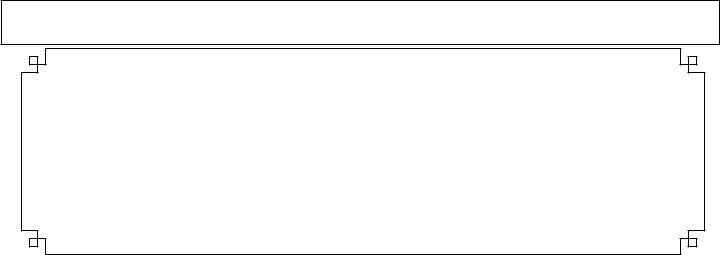
Thank You
Your purchase of this TR-1 Gold outboard management system enters you in the prestigious fraternity of anglers who count on TR-1 to control their outboard kickers.
TR-1 Autopilots is dedicated to creating the finest controls and guidance systems for the best in boating and fishing.
TR-1 Gold represents that effort. Enjoy your best fishing partner ever. We’re sure you will agree it is worth its weight in GOLD.
Table of Contents |
|
|
|
|
|
|
|
|
|
|
|
|
|
|
|
|
|
|
|
|
|
|
|
|
|
Safety & Cautions |
Page 3 |
|
||||||||||
Parts List |
Page 4 & 5 |
|||||||||||
Specifications |
Page 6 |
|
|
|||||||||
Preparation |
Page 6 & 7 |
|||||||||||
System Layout |
Page 8 |
|
|
|||||||||
Tools |
Page 9 |
|
||||||||||
Installation of E-H Unit (Pump) |
Page 9 & 10 |
|
||||||||||
Installation of Sensor Ball (Compass) |
Page 11 &12 |
|||||||||||
Installation of Deckmount/ Tach |
Page 13 |
|
|
|||||||||
Installation of Handheld/Remote |
Page 14 |
|
||||||||||
Verify Connections |
Page 14 |
|
||||||||||
Battery Connections |
Page 14 |
|
||||||||||
Connect & Fill Hydraulic System |
Page 15 |
|
||||||||||
GPS Connections |
Page 18 |
|
||||||||||
System Functions and Features |
Page 19 |
|||||||||||
Operating the System |
Page 20 |
|
|
|||||||||
Power On/Off (Deckmount) |
Page 21 |
|
||||||||||
Engaging Heading Hold |
Page 21 |
|
||||||||||
Change Heading with Remote Steer |
Page 21 |
|
||||||||||
Change Heading with RCAH (Changing Heading while in Autopilot) |
Page 22 |
|
||||||||||
GPS Steering |
Page 23 |
|
||||||||||
Setting North |
Page 23 |
|
||||||||||
Course overground |
Page 23 |
|
||||||||||
Steer to Waypoint |
Page 24 |
|
||||||||||
Orbit Waypoint |
Page 24 |
|
||||||||||
Cloverleaf Pattern |
Page 24 |
|
||||||||||
Search Pattern |
Page 25 |
|
||||||||||
Step Turns, Change Heading with |
Page 26 |
|
||||||||||
Circles, Change heading with |
Page 26 |
|
||||||||||
Reverse |
Page 26 |
|
||||||||||
MOB, change heading with |
Page 26 |
|
||||||||||
Idle/Resume |
Page 27 |
|
||||||||||
Throttle Up & Down |
Page 27 |
|
||||||||||
Zig-Zags, change heading with |
Page 27 |
|
||||||||||
Selecting Special Functions |
Page 28 |
|
||||||||||
Setup, How to make changes with |
Page 29 |
|
||||||||||
Setup Codes, Table of |
Page 30 & 31 |
|
||||||||||
Explanation of Codes |
Page 31 & 32 |
|||||||||||
Adjusting Your Autopilot (Tuning and Setup) |
Pages 33-35 |
|
|
|||||||||
Rudder and Counter Rudder Gain |
Pages 35-37 |
|||||||||||
Trouble Shooting Guide |
Page 39 |
|
|
|||||||||
2
Rev.H 101507

Safety
You are responsible for the safe and prudent operation of your vessel. Your TR-1 Gold Autopilot is a tool that will enhance your capability to operate your boat and catch fish. It does not relieve you from the responsibility for safe operation of your vessel. You must avoid hazards to navigation and never leave the helm unattended.
You must always be prepared to promptly regain manual control of your kicker. The autopilot and the throttle actuators can fail hard over. Learn to operate your autopilot on calm and hazard free open water.
In case the autopilot becomes inoperable, remove the in line fuse from the battery power cable.
The steering cylinder can be removed from its mounting bracket on the outboard in case of hydraulic jamming.
Removing the actuating link between the stepper motor and the carburetor butterfly crank can disable the electric throttle.
Caution:
Before drilling holes in your boat, be sure you know what you are drilling into. Watch out for fuel tanks, electrical cables, and hydraulic hoses.
Do not run your pilot with the outboard hard on the steering stops for any extended time or you will burn out the pump motor.
Be sure to leave the system in Standby mode when Autopilot is not in use, or if the kicker motor is not running.
We recommend you use only BioSOY hydraulic fluid in your autopilot hydraulics.
Keep your hands out of the outboard steering hinge area, the autopilot may steer the motor and smash (or worse) your fingers.
3
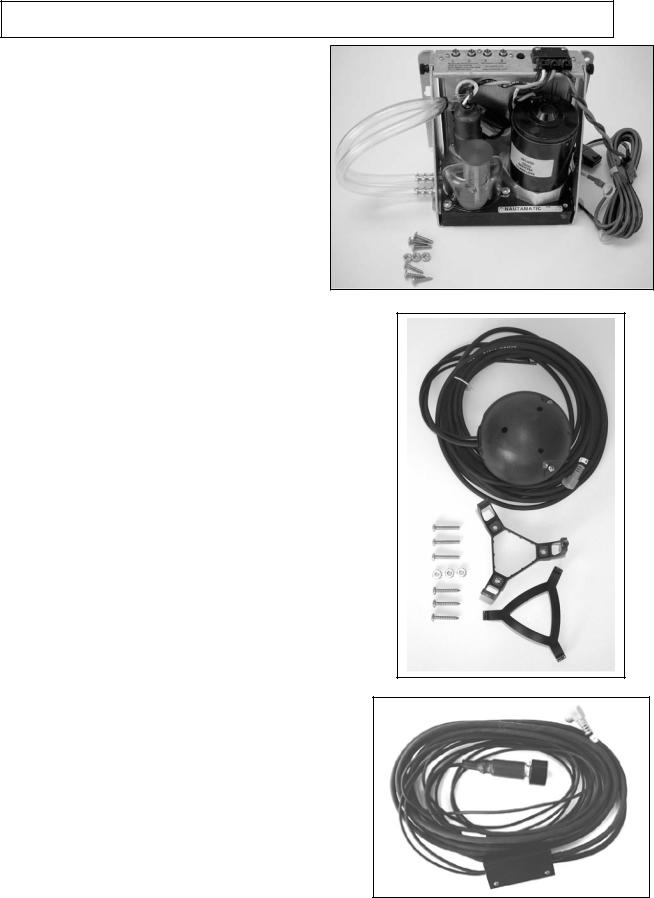
TR-1 Gold Autopilot System Parts List
Electro-Hydraulic unit……………….……. 120-2100-00
Kinked tubing with tie wrap……………….
3 ea. Truss head machine screws #8-32x 3/4 3 ea. Lock washer nuts #8-32……………… 3 ea. Truss head sheet metal screws #8 x 3/4
Sensor Ball Unit……………………………….…….. 120-2200-00
Sensor Ball Bracket ………………………………….
3 ea. Pan head machine screws #8-32 x 1”………… 3 ea. Lock washer nuts #8-32………………………… 3 ea. Pan head sheet metal screws #8 x 1”…………
Sensor Ball Capture Cage...………………………….
Deck Mount Switch/Tach …………………………
120-2215-00
4

Handheld/Remote Unit...………………………….
120-2020-00
Cylinder Mounting Kit…………………
(Motor Specific)
18 feet Hydraulic Hose…………………………………
120-0013-01
Steering Cylinder………………………………………...
120-0900-00
Throttle Actuator ( Motor Specific)……………………….
1 pt. Hydraulic Fluid
120-0001-01(Bio-Soy)………………………………
5

TR-1 Gold Specifications
E-H unit |
6.5”H x 7” W x 5” D |
8 lb |
|
Sensor Ball |
3.6” Dia. |
Cable length 18’ |
2 lb |
Remote |
5”x 2.5”x 1” |
Cable length 18’ |
1 lb |
Deckmount/Tach |
5/8”x 2” |
Cable length 6’ |
|
Battery Cable |
|
Cable length 9’ |
|
Fluid |
1 pt. |
BioSOY Oil |
1 lb |
Supply Voltage |
11.5 – 14.0 |
VDC |
|
Maximum Current |
12 |
Amperes |
|
Inline Fuse |
|
ATO 20 Amp |
|
Operating Ambient Temperature |
20 – 120 deg F |
|
|
Introduction
This manual comprises two major sections. The first section is a guide to installation of the “onboard” components of the autopilot system on your boat. The second section is a guide to adjusting and operating your system. Installation instructions for the throttle actuator and steering cylinder are motor specific and are provided in separate manuals.
Preparation
You will be hard mounting three autopilot components in your boat: 1) The Electrohydraulic Unit. 2) The Deckmount switch. 3) The Sensor ball. These components are shown in relation to each other and to the engine mounted components in the System Layout diagram on page 8. As indicated by this diagram, the Electrohydraulic unit and the Deckmount switch are to be located near the kicker and the Sensor ball is to be located FORWARD OF THE CENTER
OF YOUR BOAT
Spend some time to figure out where you are going to mount all of the components before you mount any of them. Place the components where you expect to mount them and verify you have access to and routes for the cables and hoses that connect the components.
x Mounting Screws
Mounting screws are provided for through and blind hole applications. You may choose to drill and tap the mounting surface.
SCREW |
TAP DRILL |
TAP |
CLEARANCE |
PILOT |
#8 – 32 machine |
#29 .136 dia |
#8 –32 |
|
|
#8 – 32 machine |
|
|
3/16 |
|
#8 sheet metal |
|
|
|
1/8 |
6
x Access
The Electrohydraulic Unit is the place where all the components connect together and the place where fluid is added and fluid level is checked. Leave room for service loops in the cables and hoses.
The Deckmount switch should be easy to reach with your free hand when your other hand is on the kicker tiller. This can be done after the initial turn on blinking setup is complete. In case of an emergency, quick access to the deckmount switch is a good idea, by pressing the button once it will take the autopilot to standby, allowing you to take control of the tiller handle. Pressing the button again will return it to autopilot mode.
If you intend to hook up to GPS, the connection between the GPS and the autopilot is made at the Sensor ball and the NMEA 0183 output on your GPS.
x Protection
Locate the Electrohydraulic unit and Sensor ball in places where they will not get submerged or exposed to wash down.
Use a quality electrical insuating grease compound on all electrical connections (Dow Corning #4) except the orange connectors # 1,2,3, & 4.
x Moving Parts
Hoses and cables that connect the Electrohydraulic unit to the engine mounted components need to be free from binding and kinking. Be sure to remember your kicker moves up and down on the lift bracket, tilts up and down, and steers lock to lock.
x Hose Length
Try to keep the hose length between the steering cylinder and the Electrohydraulic unit short. But leave enough length for movement of Kicker (See note above on moving Parts).
x Magnetic Environment
The Sensor ball has a compass in it. Do not mount the ball near magnetic materials, magnets (speakers and electric motors), or high current carrying wires. Small, vehicle fixed, magnetic disturbances can be calibrated out, but moveable or changing magnetic disturbances such as anchors, anchor chain, and wiper motors should be kept at least 24” away. A common problem is to have mounted the ball near a glove box, and then someone puts tools in the glove box. Keep the Sensor ball away from Air Ride seats.
x Strain Relief and Cable Protection
Do not let the connectors on the Electrohydraulic unit be the sole support for the cables connected to them. Use the tie wraps to tie the cables down to the Electrohydraulic frame. There are several holes in the sheet metal frame provided for this purpose.
Don’t run cables and hoses over sharp edges. Use grommets in through holes to protect the cables.
7
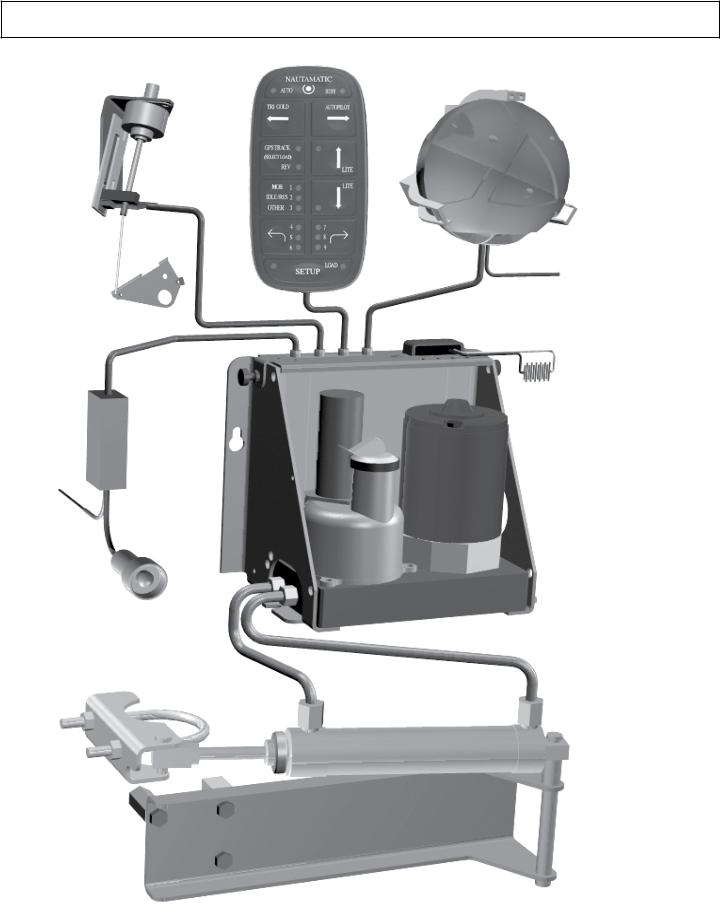
System Layout
Handheld/Remote
Throttle
Actuator
Mounts on carburetor on motor.
1 |
2 |
3 |
4 |
Tach sensor wire:Attaches to spark plug wire on kicker.
Deckmount On/Off switch: Mounts near kicker motor, near transom.
Cylinder
Sensor Ball: Mount in front 1/2 of boat.
GPS connection
NMEA 0183
Battery 12V
Electrohydraulic Unit: Mount near transom.
Cylinder Mounting Bracket: Mounts on Motor lower end.
8
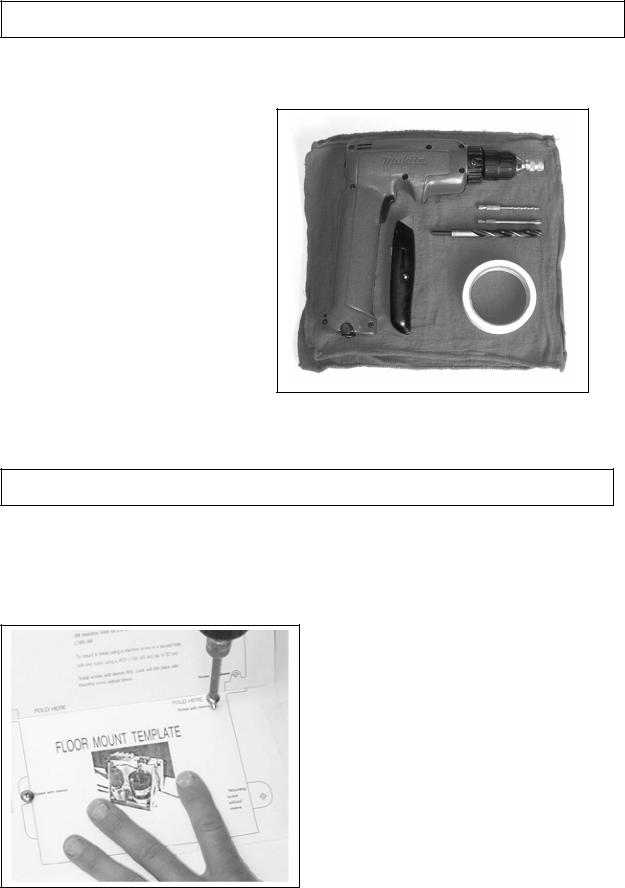
Tools
You should gather the following tools before beginning installation. See throttle and cylinder supplements for any additional tools that may be needed for your application.
Tools
Power Drill
#1 Phillips screw driver
.125 (1/8) or 3.17 mm dia. drill
.469 (15/32) or 11.90 mm dia. drill Roll of masking tape
Rags
Knife
Pliers Silicone RTV
Loctite or similar product Electrical grease compound (Dow Corning #4)
Fig .4
Installation of The Electro-Hydraulic Unit
Please read the complete instructions thoroughly before starting your installation. If you have any questions call our Tech Support line. 1-800-588-7655
Locate the Electro-Hydraulic unit where it it will not be subjected to water submersion or spray from wash down.
Step one (Template)
Find the mounting template in your autopilot documentation package. Use the wall or floor section of the template as needed. Decide which screw type you need. Hold the template in the place with tape and drill right through it in the three indicated locations. See fig.5. Remove template and install screws in the indicated locations on template. Tighten these 2 screws down to 3/32” from the surface to allow enough space for the bracket on the pump to slide behind the screw.
Fig. 5 |
9 |
|
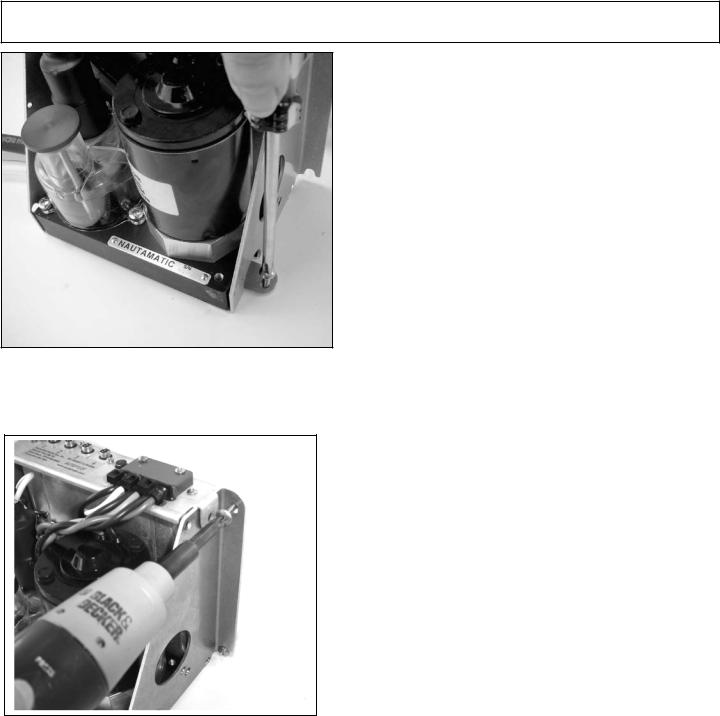
Mounting Hydraulic Unit
Fig. 6
Fig. 7
Step Two (Locking unit in place)
Floor Mount: Set the unit on the floor in front of screws. Slide the left side back and engage the notch between the hose fittings around the left hand screw. Pivot the unit on the left hand screw counter clockwise until the notch under the electronics box on the right hand side is engaged and the remaining hole you drilled lines up with the hole in the bottom tab of the right hand bracket. When the holes line up, put the last screw in and the E-H unit is locked in place, as shown in fig.6.
Wall Mount: Set in place by hanging the unit on the screws. One is the keyhole shape on the upper left backside of E-H unit; the other is the notched area on the lower right side of E-H unit. Lock E-H unit in place by lining up the last hole on upper right hand corner. Please note: You will need to remove the black plastic thumbscrew to place the last screw, as shown in fig.7
You may run the red and black wires to the battery box now, but do not connect to the battery yet.
10
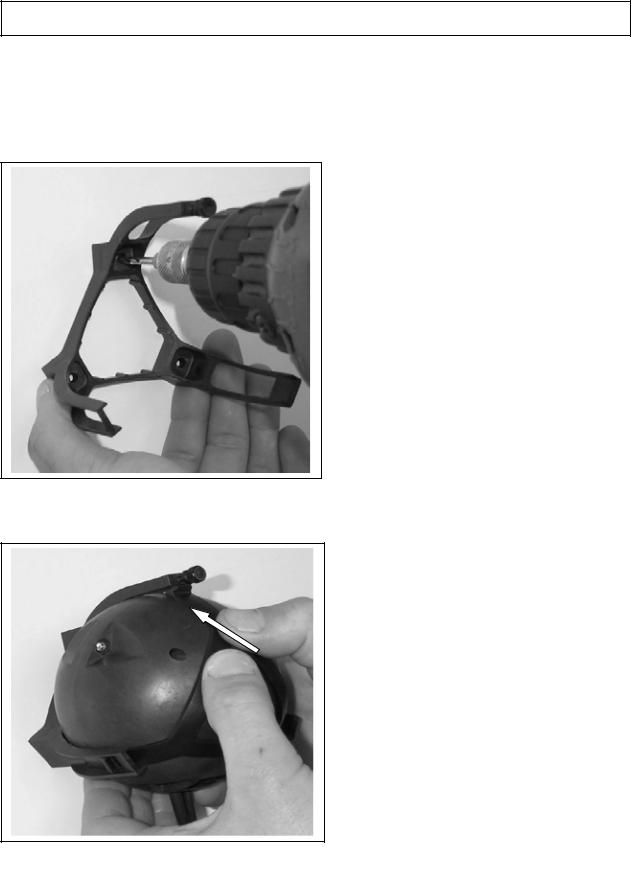
Installation of the Sensor Ball
The Sensor (Compass) Ball needs to be mounted forward of the center of your boat. Make sure you mount it away from magnetic disturbances (stereo speakers, wiper motors, anchors). You will need to calibrate your compass on the water after installation of system and before you use the autopilot.
Step one (Mounting the Sensor Ball)
Hold the mounting bracket in the desired position and drill through the holes into the mounting surface. (Be sure that the wire coming out of the ball can exit the ball straight down.) Tap if necessary. Install and tighten the three mounting screws as shown in fig.8-a
If you need to make a paper template for a drill pattern: The mounting holes are equally spaced on a 1.224 inch radius circle.
Fig. 8-a
Step two (Placing ball in bracket)
Place the ball, wires down, into the bracket and capture it by snapping the cage over the ball, sliding the tips of the cage between the ball and the legs of the bracket. Do the two legs without the thumbscrew first. Rotate cage upwards to catch the bracket with the thumbscrew. See fig. 8-b
Fig. 8-b
11
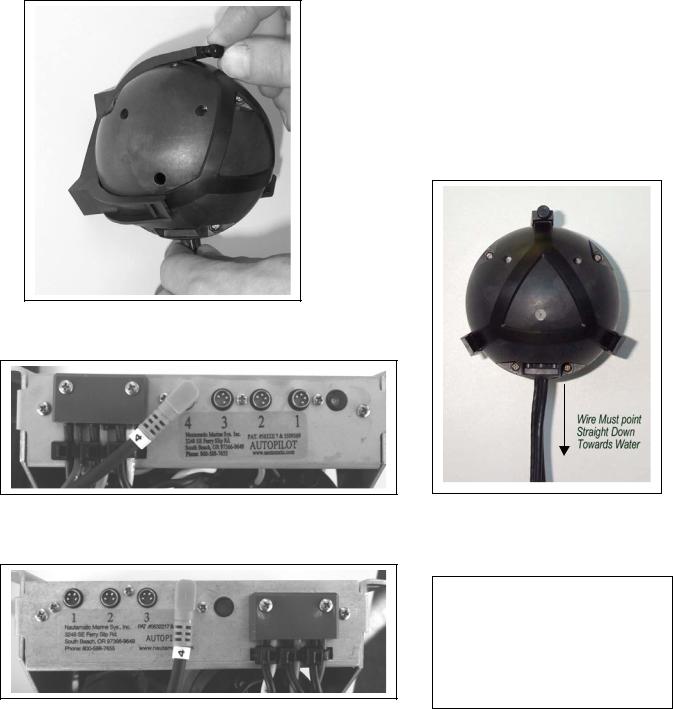
Fig. 9-A
Fig. 10-a
Step 3 (Adjusting Sensor Ball)
Readjust the ball if necessary and fix it in position by tightening the thumbscrew. See Fig 9-A. Make sure that the wires from the Sensor Ball are pointing straight down out the bottom; otherwise the sensor ball will not work properly. See Fig. 9-B
Fig. 9-B
Note: It is important to match your ECU wiring configuration to the picture. Just remember to always plug into matching numbers from the wire to the ECU.
Fig. 10-b
Run the wire back to the E-H unit. The wire connector from the Sensor Ball is labeled number 4. It connects to the E-H unit at connector 4, as shown in fig.10-a or 10-b. (this will depend on
your ECU wiring configuration). When you plug in the connectors, the wires go at about a 45q- angle left of the numbers on the E-H unit (fig. 10-a) or at a 90° angle for fig 10-b. Feel the connectors start before pushing it down.
12
